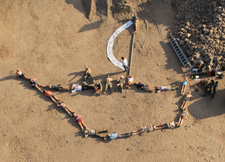WENDY J. GOLDHIRSH TEL DOR ARCHAEOLOGICAL FELLOWSHIPS
2017-2018 Fellow
- Cornelia Torn Broer (Department of Archaeology, the Hebrew University of Jerusalem)
- M.A. Thesis
- The Monumental Stone Building at Tel Dor.
2014-2015 Fellow
- Harel Shohat (Institute of Archaeology, University of Haifa)
- M.A. Thesis
- A Cultural Change at Dor in the Iron Age II. The Annexation of Dor to the Kingdom of Israel – Stratigraphical and Typological Analysis of the Findings from Area D2.
2012-2014 Fellow
- Yuli Gekht (Department of Archaeology, the Hebrew University of Jerusalem)
- M.A. Thesis, The Hebrew University of Jerusalem
- A Hellenistic Public Structure in Area D at Dor: Stratigraphy, Date, Identification and Architectural Analysis
2009-2011 Fellow
- Barak Monnickendam-Givon (Department of Archaeology, the Hebrew University of Jerusalem)
- M.A. Thesis
- Plain Ware of the Southern Carmel Coast during the Late Persian to Hellenistic Periods
- Abstract
- The purpose of my research is to analyze the plain wares pottery assemblages in the Late Persian and Hellenistic periods from The Southern Carmel Coast Region. Doing so lets me to present a new contextual ceramic paradigm based upon the results of excavations from recent years in Tel Dor and Horvat Eleq(Ramat Hanadiv). Two sites with different nature (a central harbor city and a rural estate), that were excavated in recent years. So modern methods of separation between the different loci and ceramic assemblages were implied during the course of excavation.
2007-2008 Fellows
Department of Archaeology, the Hebrew University of Jerusalem
- M.A. Thesis
- The Urbanization of Southern Phoenicia during the 6th and 5th Centuries BCE
- Abstract
- The urbanization of the costal region of Israel during the Persian Period is well represented in archaeological literature. The common approach today produces a picture of a rapid renewal of settlements at beginning of the Persian period at the late 6th century BCE in an area mostly uninhabited during the Babylonian Period.
The objective of this research is to produce an alternative model based on a re-evaluation of published material from several Persian Period sites, while incorporating certain geographic and economic perspectives. The outcome should show that urbanization occurred gradually as opposed to rapidly, reaching maturity in the late 5th century BCE.
BRONWEN MANNING
- Topic
- Abstract
- For the Wendy J. Goldhirsh Fellowship 2007-2008 this scholar seeks to examine in detail the stratigraphy and ceramic assemblage from the Neo-Assyrian to Babylonian strata of Area D2 of the Tel Dor Excavations. To date, Area B1 (being prepared for publication) is the only other area from the site that has yielded significant Assyrian finds that can contribute to our understanding of this often misunderstood period in the region's history. Therefore, the study and publication of both the stratigraphy and pottery from Area D2 can and will greatly add to and clarify our knowledge regarding the nature of Assyrian Dor.
HAGAR BEN BASAT
Department of Archaeology, University of Haifa
- Topic
- BEADS AND PENDANTS AT TEL DOR DURING THE EARLY IRON AGE: ORIGIN, TECHNOLOGY AND SOCIAL PERSPECTIVES
- Abstract
- This study, conducted as part of the author's M.A. degree in archaeology, will classify the beads and the pendants from Tel Dor typologically and define the various materials that assemble this corpus using analytical chemistry methods for finding mineralogical composition, alongside petrography and radiography. This study will tackle several issues regarding the origin of these beads, their manufacturing technology, and their conservation conditions. This research, together with cataloguing and curation work at the Glasshouse museum, will enrich the Tel Dor Project with new knowledge on aspects of previously unprocessed finds, attained by the application of advanced scientific research methods.
